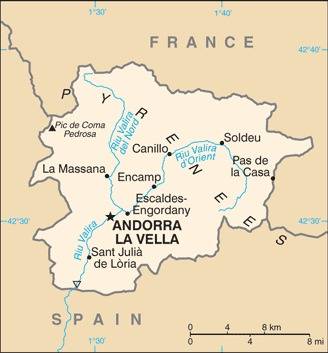55 Andorra

Three vertical bands of blue (hoist side), yellow, and red, with the national coat of arms centered in the yellow band. The latter band is slightly wider than the other 2 so that the ratio of band widths is 8:9:8. The coat of arms features a quartered shield with the emblems of (starting in the upper left and proceeding clockwise): Urgell, Foix, Bearn, and Catalonia. The motto reads VIRTUS UNITA FORTIOR (Strength United is Stronger). The flag combines the blue and red French colors with the red and yellow of Spain to show Franco-Spanish protection.
Flag courtesy of the CIA World Factbook

Map courtesy of the CIA World Factbook

Composite satellite image of the Pyrenees. Andorra lies about one-third of the way into the range from the east (right). The country is composed primarily of rugged mountains, but these are dissected by three narrow valleys where most of the populace lives.
Photo courtesy of the CIA World Factbook
Government
According to Britannica, historically, the coprinces (the French president and the bishop of Urgel) represented Andorra internationally and jointly headed the government through their delegates. The elected members of Andorra’s unicameral legislature, the 28-member General Council of the Valleys, were responsible for internal administration and functioned as both an informal legislature and a cabinet headed by a prime minister. The 1993 constitution, approved by Andorran voters in a referendum, changed this structure and transferred most of the powers of the coprinces to the General Council, which became a true national parliament elected by universal suffrage. Every four years, the General Council elects an Executive Council president who heads the government and who then chooses cabinet members. The government was newly empowered to raise revenues through taxation, to create an independent judiciary, to give citizens the right to form political parties and trade unions, and to control its foreign policy and join international organizations. The coprinces remained the constitutional heads of state, though this role was largely ceremonial. In the early 21st century the main political parties were the centre-right Democrats for Andorra, the Social Democratic Party, and the Lauredian Union.
Ministry of Public Administration, Transport, and Telecommunications
Government of Andorra states that the Ministry of Public Administration, Transport and Telecommunications is in charge of aviation matters.
Airspace
SkyVector – Google Maps – ADS-B Exchange
ICAO countries publish an Aeronautical Information Publication (AIP). This document is divided into three parts: General (GEN), En Route (ENR) and Aerodromes (AD). ENR 1.4 details the types of airspace classes they chose to adopt from classes A through G.
Drone Regulations
Air Navigation Law, of November 9, 2000
Regulation of unmanned, remotely piloted aircraft, of February 24, 2016
Law 15/2003, of December 18, on the protection of personal data.
Advanced Air Mobility (AAM) Regulations & Policies
None found by the author.
However, should you, the reader, happen to stumble across something to the contrary, please email the author at FISHE5CA@erau.edu and you may be mentioned in the ACKNOWLEDGEMENTS section of this book by way of thanks for contributing to this free eBook!
Advanced Air Mobility (AAM) News
None found by the author.
However, should you, the reader, happen to stumble across something to the contrary, please email the author at FISHE5CA@erau.edu and you may be mentioned in the ACKNOWLEDGEMENTS section of this book by way of thanks for contributing to this free eBook!
Short Essay Questions
Scenario-Based Question
You have been hired by a Drone Startup Company. Your boss has immediately assigned this job to you.
They need you to prepare a one-page memo detailing the legalities of using a drone to search for a party of missing hikers in the Pyrenees, pictured above.
They need you to mention any national laws and local ordinances.
They specifically want to know what airspace (insert pictures) you will be operating in and whether or not you need an airspace authorization.
Does it matter whether or not you are a citizen of the country?
Lastly, there is a bonus for you if, as you scroll through this chapter, you find any typos or broken links!
Short Essay Questions
- What are the drone categories?
- How is registration addressed?
- How is remote ID addressed?
- What are the model aircraft rules?
- What are the commercial drone rules?
- Are there waivers or exemptions to the rules? If so, for what?
- Would you share a link to an interactive airspace map?
- How is BVLOS addressed?
- How can you fly drones at night?
- How can you fly drones over people?
- Where do you find drone NOTAMs?
- What are the rules for drone maintenance?
- What are the rules for an SMS program?
- What are some unique rules not mentioned above?
- What are the C-UAS rules?
- What are the AAM rules?

